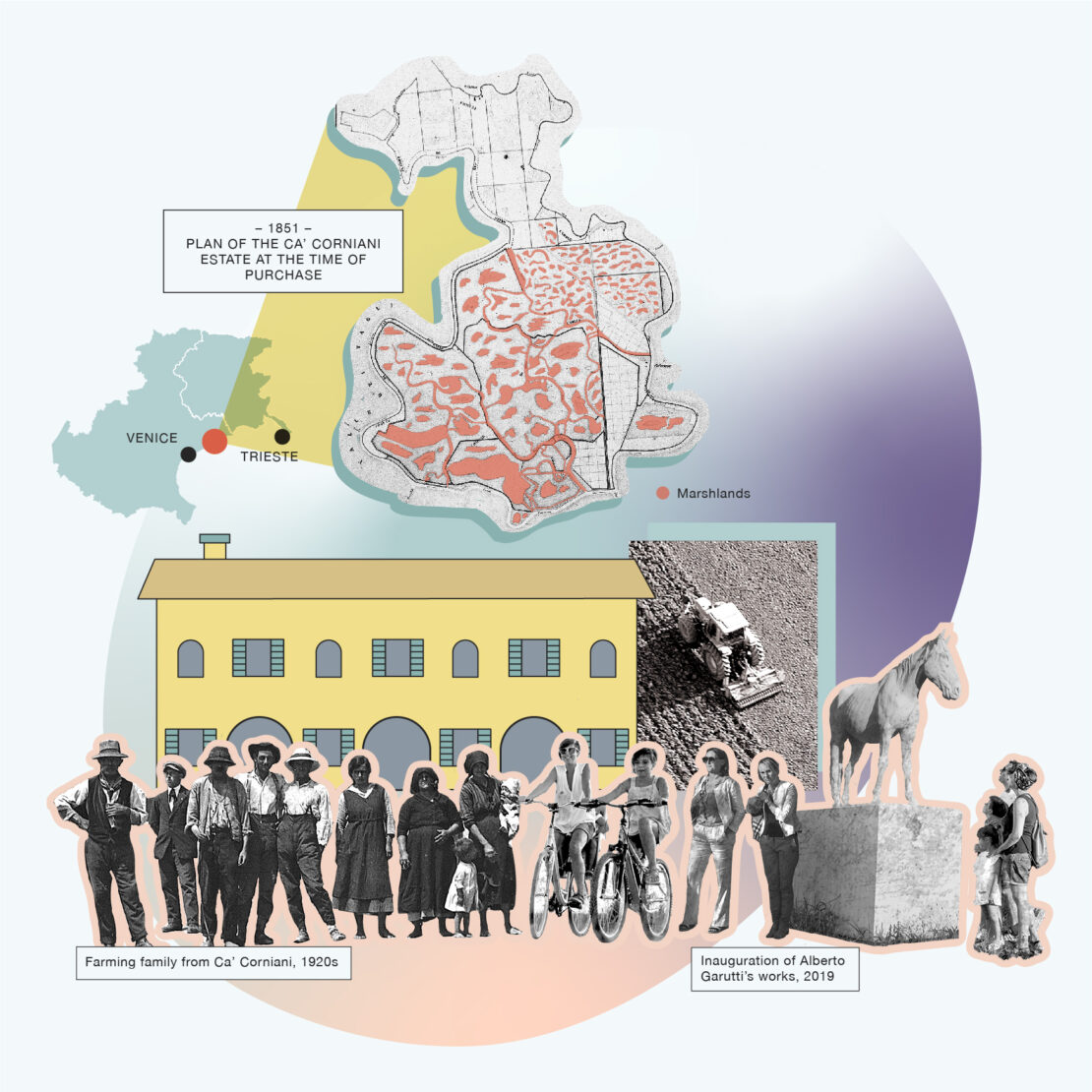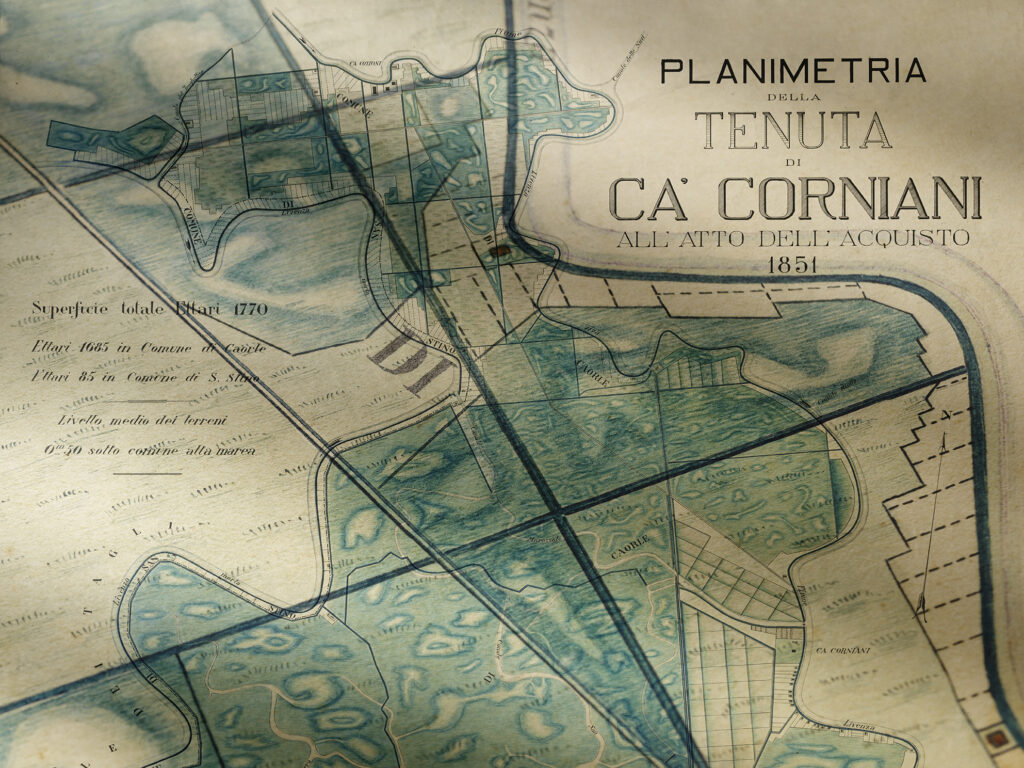1851 – The Ca’ Corniani Communities in 170 Years of History
Generali’s agricultural holdings form part of that vast set of asset guarantees that the company has made available in order to meet its commitments to policyholders. This unusual type of activity requires a concrete specialisation, and the results it yields are all the more appreciable the more it contributes to agricultural and community development. Twenty-five companies currently make up Generali’s agricultural assets, with Ca’ Corniani among the largest.
The estate consists of over 1700 hectares located in the area of Caorle and San Stino, on the north-western border of the great Adriatic lagoon, between the Livenza and Tagliamento rivers. It was purchased by Generali in 1851, on the initiative of the Venetian Office Secretary Daniele Francesconi, and is linked to one of the first and largest reclamation works in Italy. The lagoon around Caorle was formerly owned by the Venetian Republic, which allowed the locals to use it for hunting and fishing. The area was then divided into parcels and sold to the nobles; the third and the fourth lots, namely the Ca’ Corniani area, were in part owned by the family of the same name. At the time of purchase, the property consisted of marshland and marginal land put to farming use. The existing buildings were limited to some small houses for farm workers and a few cottages built of clay, straw, and timber.
Between 1851 and 1917, Generali engaged in pioneering reclamation work: it endowed the Livenza with embankments, ditches, and canals to carry away water, through steam-driven pumps. It then built the doctor’s house, with adjoining surgery for visits, the nursery, school, post office, church and rectory, and accommodation for the families of tenant farmers and farm workers, thus gradually shaping the great community of Ca’ Corniani, through careful planning.
For the company, it was a choice to diversify its real estate investments, equating it to what the same Venetian landowner class as a whole was then realising. Among them were plenty of representatives of the company’s shareholders: large landowners who had been concerned since the 1850s with greater agricultural development and rehabilitation of the region. Although linked to a principally agricultural economic perspective, they seem to have been the preferred insurance addressees of Francesconi, whose attention was focused on increasing the traditional fire and hail sectors rather than the more modern and innovative life insurance sector.
The choice of real estate investment was not only prudent, but also virtuous, because it triggered a positive dynamic for the company. The radical reclamation work, the first of its kind in Italy to be carried out by private individuals and in advance of State intervention, not only led to the establishment of the first of the company’s farms, but also involved the local community, improving working and health conditions, as well as cultural development. In addition to a job, residents on the estate had a health service, training courses, schools for children, a seaside holiday camp, and a recreation centre. It was a model of corporate welfare, the result of an avant-garde vision of farming activity founded on a model of sustainable development.
This organisation also had civil implications, so to speak. During World War I, Ca’ Corniani sacrificed itself to defend the region: on the eve of the battle of Caporetto, the area was flooded by the retreating Italian army to slow the advance of the Austrians, who then occupied and devastated the region, necessitating a new reclamation. Ca’ Corniani was again at the forefront in 1951 to support the population after the Polesine flood, offering hospitality to a hundred children left homeless.
Ca’ Corniani’s agricultural production figures spoke for themselves from the early years: the farm moved from an average grain production equal to 3000 quintals in the three years preceding the reclamation to 16,000 in 1884. Cattle numbers grew from 250 to 1,090 at the end of 1883. The population rose from 340 inhabitants, in poor health, to 1,066, in full health. Malaria was eradicated by 80%.
Bearing in mind that in northern Italy, in the early twentieth century, about 70% of the population was illiterate and undernourished, that in the countryside men, women, and children often shared their houses with animals, and there were many widespread diseases, it was an absolute innovation.
Obviously, the progress was not without its setbacks: the aforementioned flooding, which failed to prevent the occupation and devastation of the region by the Austrians, lasted until May 1919. The damage amounted to nearly 5 million lire, without considering the loss of produce. Reconstruction and improvement of the estate took place almost entirely at Generali’s expense, and successfully restored work to almost 1,500 farmers. Efficiency and productivity were restored from 1921 and, over a period of two years, Ca’ Corniani was awarded first prize for wheat production and for livestock breeding in regional competitions and shows.
The estate experienced a period of depopulation in the late 1950s, following the mechanisation of agricultural work. Later, Ca’ Corniani became part of Genagricola, the company uniting the Italian agricultural sector of the Generali Group. Established in 1974, Genagricola has represented the natural evolution of the estate into a specialised agri-food company, starting its business with the acquisition of numerous estates (currently 25) and, since 1980, assuming control of all of the Group’s farms as a holding company wholly owned by Generali.
For some years, the entire region of Ca’ Corniani has been the heart of a development project. The core of the agricultural estate founded in 1851 is now a large multifunctional centre. Visitors can choose to access it from three different “thresholds”, works created by the artist Alberto Garutti for Ca’ Corniani that describe the characteristics of this place in a contemporary way: the large golden roof of an old farmhouse, LED lettering that lights up for every lightning bolt that strikes in Italy, portrait sculptures of the farm dogs and horses.
Visitors can enjoy excursions, on foot or by bicycle, along the paths inside the estate, stop in the picturesque viewpoints, and visit the historic and recently restored Ca’ Corniani pumping station, where the reclamation work is described through an interactive itinerary. In the summer, there is a packed calendar of open-air theatrical performances and film screenings, photographic exhibitions, and multimedia installations, which complete the story of the land, with its biodiversity and its history.

